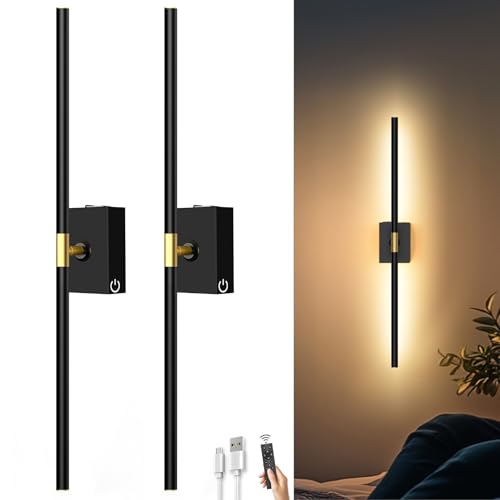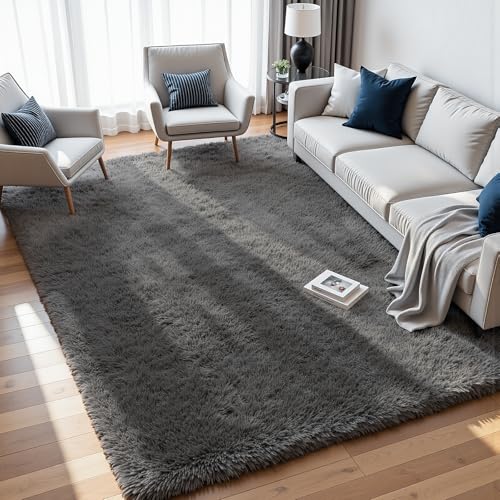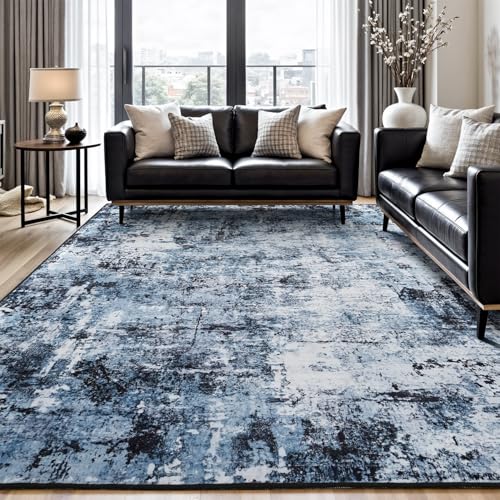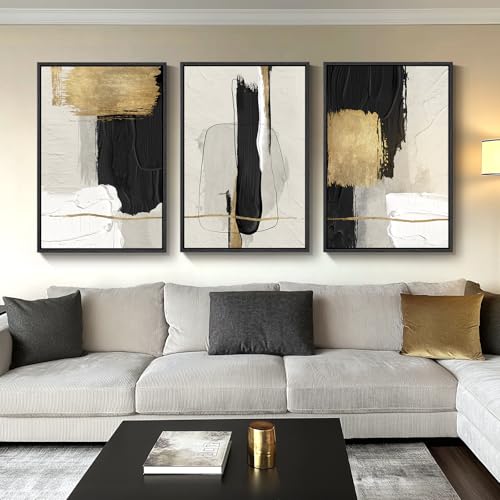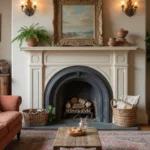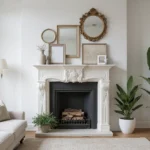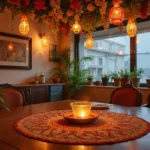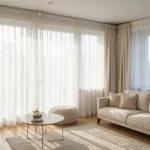Looking to transform your bedroom into a tranquil sanctuary? We’ve discovered that lavender—in all its dreamy variations—might be the perfect color choice for creating that serene sleep space you’ve been craving. This gentle purple hue doesn’t just look stunning; it’s scientifically proven to promote relaxation and better sleep quality.
From soft lilac to deep amethyst, lavender shades offer versatility that works with virtually any design aesthetic. We’ll guide you through the most enchanting lavender palettes that can elevate your bedroom from ordinary to extraordinary. Whether you’re planning a complete bedroom makeover or simply wanting to refresh your space with calming colors, these lavender inspirations will help you create the peaceful retreat you deserve.
10 Dreamy Shades of Lavender for the Perfect Bedroom Sanctuary
1. Whisper Lilac
Whisper Lilac offers the lightest touch of lavender for bedrooms seeking subtle elegance. This barely there shade creates an airy atmosphere that pairs beautifully with white furniture and silver accents. Many designers recommend this hue for smaller bedrooms that need to maintain brightness while still incorporating color. Perfect for minimalist aesthetics, Whisper Lilac provides just enough color to prevent a space from feeling stark.
2. French Lavender
French Lavender captures the essence of Provence countryside with its authentic purple blue undertones. This classic shade evokes the rolling lavender fields of southern France and brings their calming properties directly into your bedroom. Several studies suggest this particular lavender tone may help reduce anxiety and promote better sleep quality. French Lavender works wonderfully with natural wood elements and linen textiles for a rustic yet sophisticated look.
3. Dusty Lavender
Dusty Lavender introduces a sophisticated gray undertone that creates depth and dimension in any bedroom. This muted shade feels both contemporary and timeless, making it a favorite among interior designers for versatile appeal. Many homeowners choose this color for its ability to transition seamlessly between seasons without feeling overpowering. Dusty Lavender pairs exceptionally well with cream, taupe, and charcoal accents.
4. Lavender Mist
Lavender Mist presents a dreamy, watercolor quality that softens the entire bedroom environment. This ethereal shade creates the perfect backdrop for a truly serene sanctuary where stress melts away. Paint companies often highlight this particular lavender as a top choice for promoting restful sleep and relaxation. Lavender Mist complements nearly any decor style from contemporary to traditional with its balanced purple undertones.
5. Amethyst Dream
Amethyst Dream delivers rich, jewel toned depth for those seeking bold lavender impact. This luxurious shade evokes a sense of opulence and creates a cocooning effect that transforms bedrooms into true retreats. Design experts recommend using this deeper lavender as an accent wall behind the bed to create a stunning focal point. Amethyst Dream pairs beautifully with gold hardware, velvet textures, and cream colored linens.
6. Lavender Fog
Lavender Fog blends subtle purple with cool gray undertones for a sophisticated contemporary look. This balanced neutral creates a sense of calm while maintaining enough personality to avoid feeling bland or clinical. Color psychologists note that this particular shade promotes mental clarity while still providing the soothing benefits associated with lavender. Lavender Fog works wonderfully in modern minimalist bedrooms with clean lines and simple silhouettes.
7. Sweet Lavender
Sweet Lavender brings a youthful, cheerful energy to bedroom spaces with its medium toned purple pink undertones. This vibrant yet still soothing shade works perfectly in teen bedrooms or guest rooms that benefit from a positive atmosphere. Interior stylists frequently pair this shade with white furniture and yellow accents for a fresh, springtime feel year round. Sweet Lavender creates an instantly uplifting environment while maintaining the calming properties of the lavender family.
8. Twilight Lavender
Twilight Lavender captures the magical blue purple hue seen in evening skies during dusk. This enchanting shade creates a dramatic yet peaceful atmosphere that’s perfect for bedrooms focused on creating a true escape from daily life. Many homeowners report this deeper lavender tone helps create the perfect ambiance for unwinding after stressful days. Twilight Lavender looks stunning with silver metallics, navy blue accents, and crisp white linens.
9. Lavender Sage
Lavender Sage introduces a fascinating green undertone that gives this lavender variation unique versatility and earthy appeal. This uncommon shade bridges the gap between cool and warm color families, making it exceptionally adaptable to different lighting conditions. Design professionals often recommend this particular lavender for north-facing bedrooms that need warming up. Lavender Sage creates a beautiful foundation for nature-inspired bedroom designs with botanical accents.
10. Royal Lavender
Royal Lavender delivers the deepest, most saturated option for those seeking lavender’s benefits with maximum impact. This bold purple shade creates a sense of luxury and sophistication while still maintaining the meditative qualities lavender is known for. Color experts suggest using this rich hue sparingly in bedrooms, perhaps as an accent wall or in plush textiles like velvet drapes or bedding. Royal Lavender pairs magnificently with brass fixtures, cream accents, and dark wood furniture for a truly regal bedroom retreat.
Soft Lilac: The Gentle Pastel That Soothes the Soul
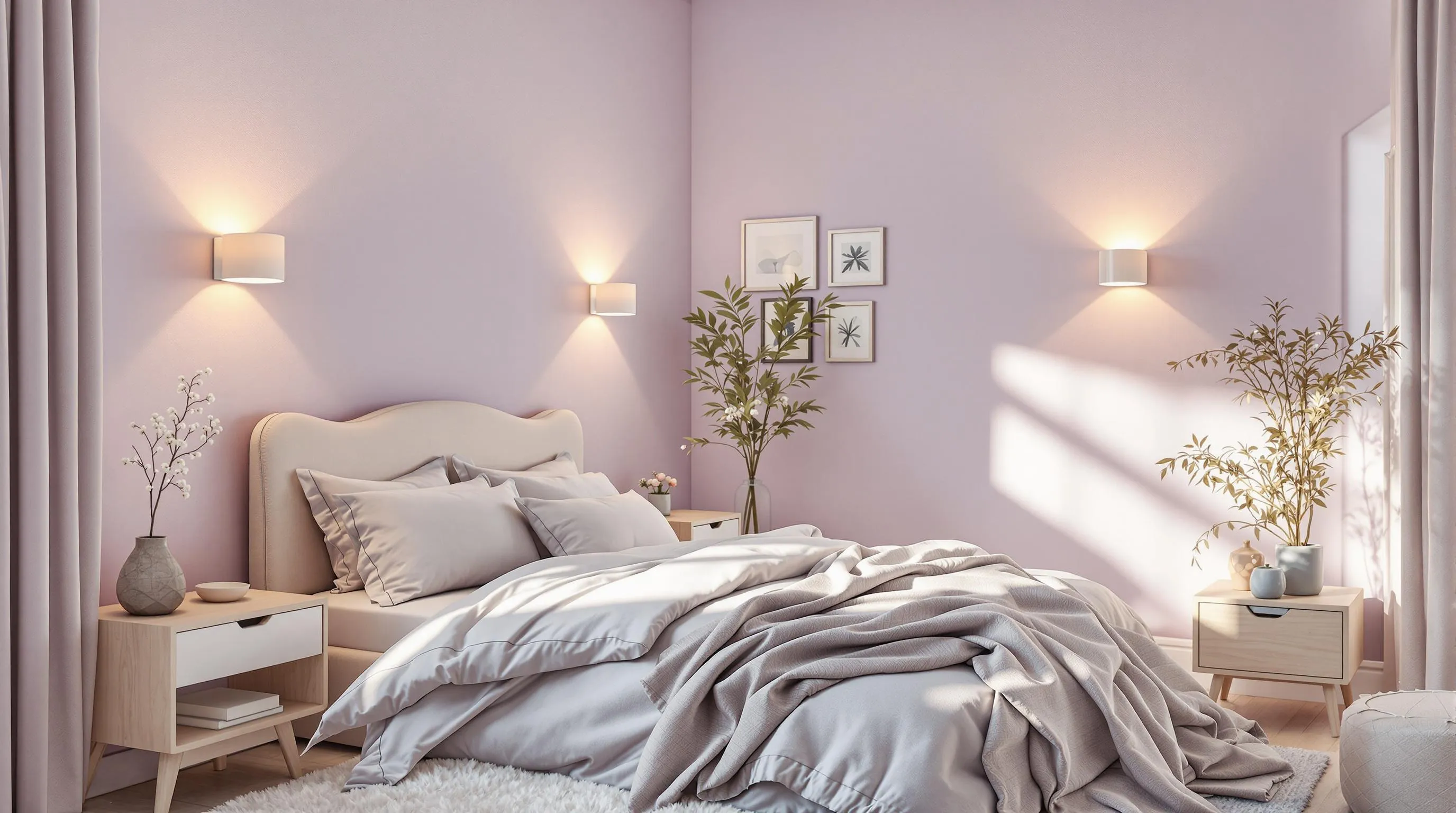
Soft lilac creates an atmosphere of tranquility and mental calmness that’s perfect for bedroom sanctuaries. This gentle shade evokes spirituality, relaxation, and emotional balance, serving as a psychological buffer against daily stress. Pale lavender mimics natural serenity similar to soft blues and greens, promoting harmony and restorative sleep. Modern designers have embraced lilac’s sophisticated, gender-neutral qualities as an excellent alternative to stark tones like grey, offering a subtle, calming presence in contemporary spaces.
How to Pair Soft Lilac with Neutral Furnishings
Pairing soft lilac with neutral tones creates a balanced, contemporary aesthetic that maintains the room’s serene vibe. We recommend combining lilac walls with soft grey, beige, or cream furnishings to enhance the room’s calming atmosphere without overwhelming the space. Textured linen bedding complements lilac perfectly, adding dimension while preserving the room’s tranquil feel. Light wooden furniture brings warmth to the color scheme, creating a harmonious balance between cool and warm elements. Matte finishes work exceptionally well with lilac, preventing visual competition that might disrupt the peaceful ambiance. For added depth, incorporate charcoal accents or metallic elements like brass lamps as visual anchors without compromising the room’s soothing quality.
Best Lighting Options to Enhance Soft Lilac Walls
Lighting plays a crucial role in showcasing soft lilac’s calming properties effectively. Warm white LED bulbs (2700K–3000K) amplify lilac’s soothing effect, creating a cozy atmosphere that encourages relaxation. Wall sconces provide gentle, diffused lighting that highlights the subtle undertones in lilac walls without harsh shadows. Dimmable fixtures offer flexibility to adjust the ambiance according to different times of day or activities. Natural light softens lilac’s undertones during daytime hours, showcasing its ethereal quality. Positioning mirrors opposite windows maximizes light diffusion, ensuring the color maintains its airy appearance throughout the day. Candlelight-style LEDs introduce a warm glow that complements lilac’s harmonious undertones during evening hours. Salt lamps serve as excellent accent lighting options, their amber glow creating a beautiful contrast against soft lilac walls while maintaining the room’s tranquil atmosphere.
Periwinkle Lavender: Where Purple Meets Blue in Perfect Harmony
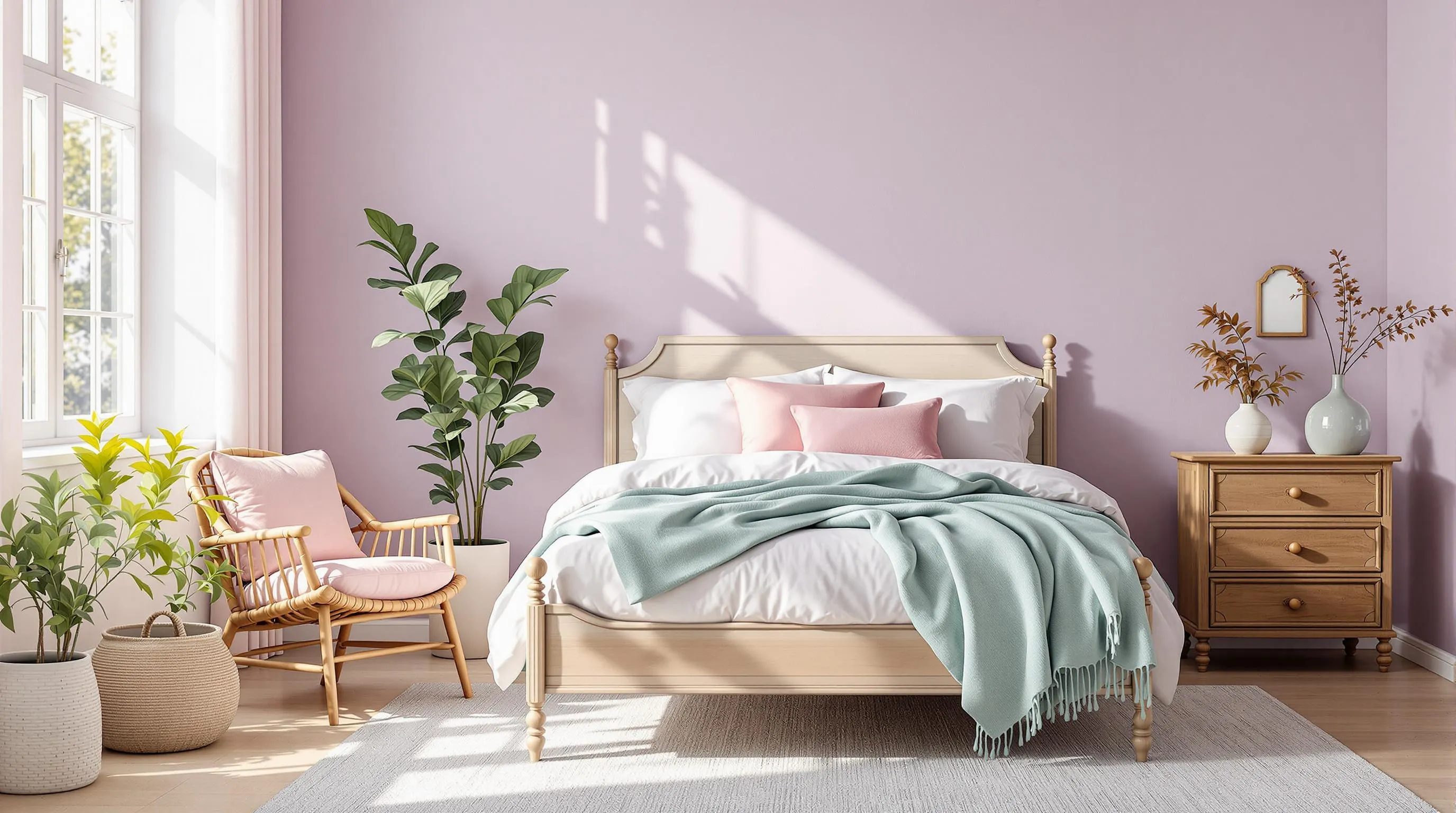
Periwinkle lavender sits at the fascinating intersection where purple meets blue, creating a uniquely serene color experience. Unlike pure lavender which tends toward purple, periwinkle lavender leans more into the blue-violet spectrum, offering a slightly different energy while maintaining lavender’s calming properties.
Complementary Accent Colors for Periwinkle Spaces
Periwinkle lavender truly shines when paired with carefully selected accent colors that enhance its dreamy quality. Soft pastels like baby pink, light blue, and mint green establish a harmonious palette that amplifies periwinkle’s soothing ambiance. Neutral tones work exceptionally well too, with white, cream, and light gray maintaining a clean, minimalist aesthetic that allows periwinkle to be the gentle star. Earth tones bring welcome warmth to periwinkle spaces—consider introducing brown, beige, or natural wood accents to add coziness and ground the airy blue-purple hue. For those seeking a unified color story throughout their bedroom, these complementary colors offer versatility for either minimalist designs or more eclectic approaches.
Furniture Styles That Shine with Periwinkle Lavender
Furniture selection plays a crucial role in improving periwinkle lavender’s dreamy effect in bedroom spaces. Vintage or antique pieces pair beautifully with this color, adding touches of elegance and sophisticated character that complement the gentle hue. Minimalist designs featuring clean lines and simple shapes naturally enhance the serene atmosphere that periwinkle lavender creates, allowing the color to speak without competition. Pieces crafted from natural materials make particularly striking companions—wood, rattan, and wicker furniture enhance the organic feel of a periwinkle room while adding textural interest. The subtle blue undertones in periwinkle lavender make it especially adaptable to various design styles, from contemporary to traditional, giving you freedom to express your personal aesthetic while maintaining the color’s calming benefits.
French Lavender: The Classic Shade That Never Goes Out of Style
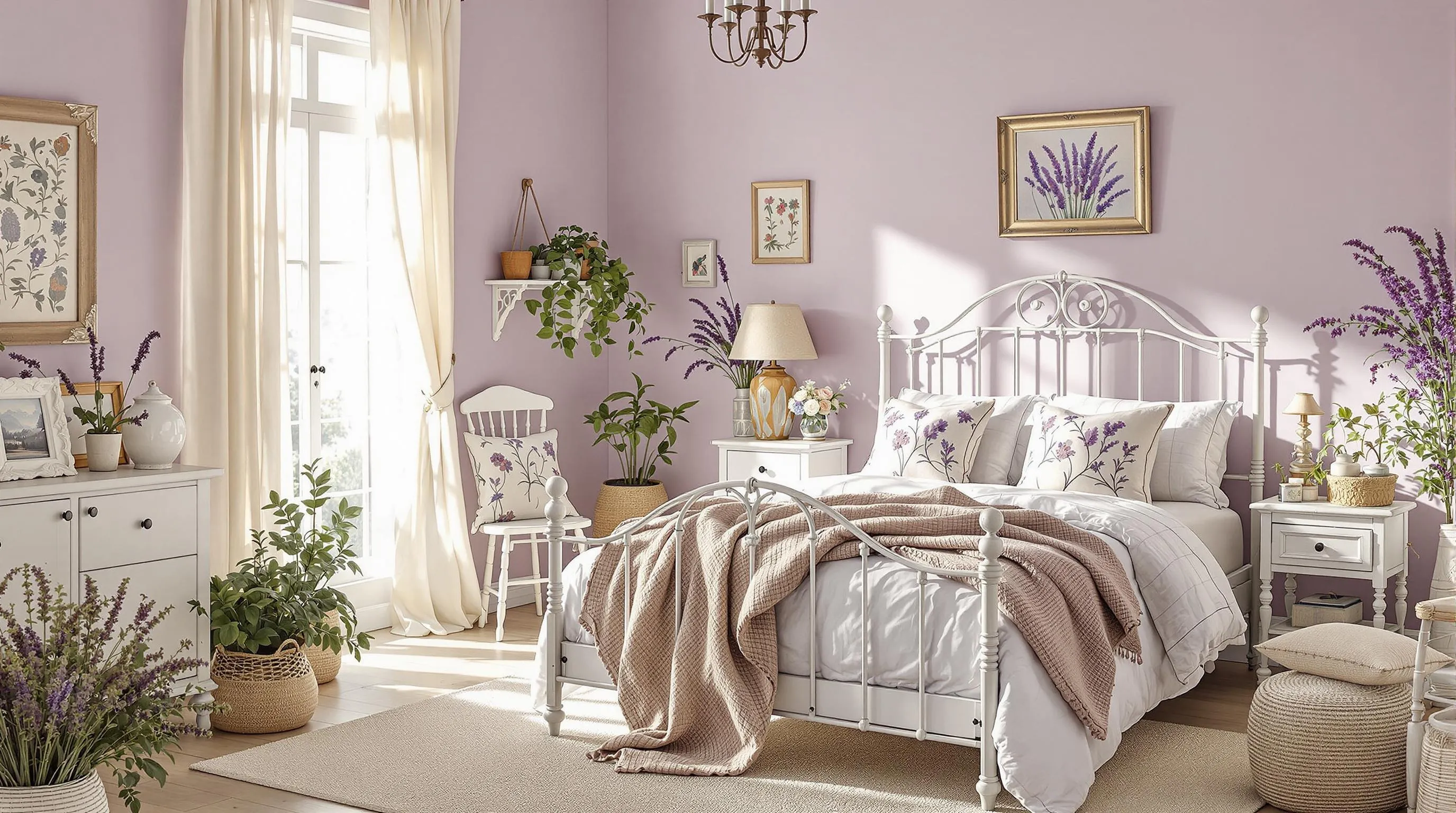
French Lavender stands as a timeless choice for bedroom designs, offering a soft violet-gray tone that instantly evokes the picturesque lavender fields of Provence. This muted yet warm shade pairs beautifully with antique wood furnishings and distressed finishes, creating a serene atmosphere that remains eternally stylish.
Creating a Provence-Inspired Bedroom with French Lavender
Transform your bedroom into a rustic French countryside retreat by pairing French lavender walls with whitewashed furniture pieces that complement the color’s subtle intensity. Wrought-iron accents add authentic character while maintaining the provincial aesthetic that defines this classic style. Incorporate sheer cream curtains to balance the lavender’s depth, allowing natural light to filter through and maintain an airy feeling throughout the space. Rustic decor elements like burlap textiles or dried lavender bundles enhance the authentic Provençal atmosphere. Consider adding soft floral patterns in complementary hues or botanical prints to bring a natural touch that feels organically connected to the lavender theme. These patterns work especially well on accent pillows, area rugs, or framed artwork.
Natural Elements That Enhance French Lavender Walls
Light wooden accents create perfect harmony with French lavender walls, as elements like oak bed frames or reclaimed wood nightstands add warmth without competing with the gentle color palette. Botanical decorations further enhance the organic quality of a French lavender bedroom—try incorporating potted lavender plants, eucalyptus stems, or framed botanical artwork to reinforce the natural aesthetic. Textured linens in neutral tones bring depth and dimension to the space; layer jute rugs, linen pillowcases, and throw blankets in complementary colors like crisp white for contrast, soft gray for sophistication, or dusty pink for subtle warmth. For a balanced approach without fully committing to lavender throughout the room, consider creating an accent wall in French lavender while keeping remaining walls in complementary neutrals. Renters might explore peel-and-stick wallpaper in lavender geometric or damask patterns as a low-commitment option that still captures the essence of this timeless shade.
Dusty Lavender: The Sophisticated Choice for Modern Bedrooms
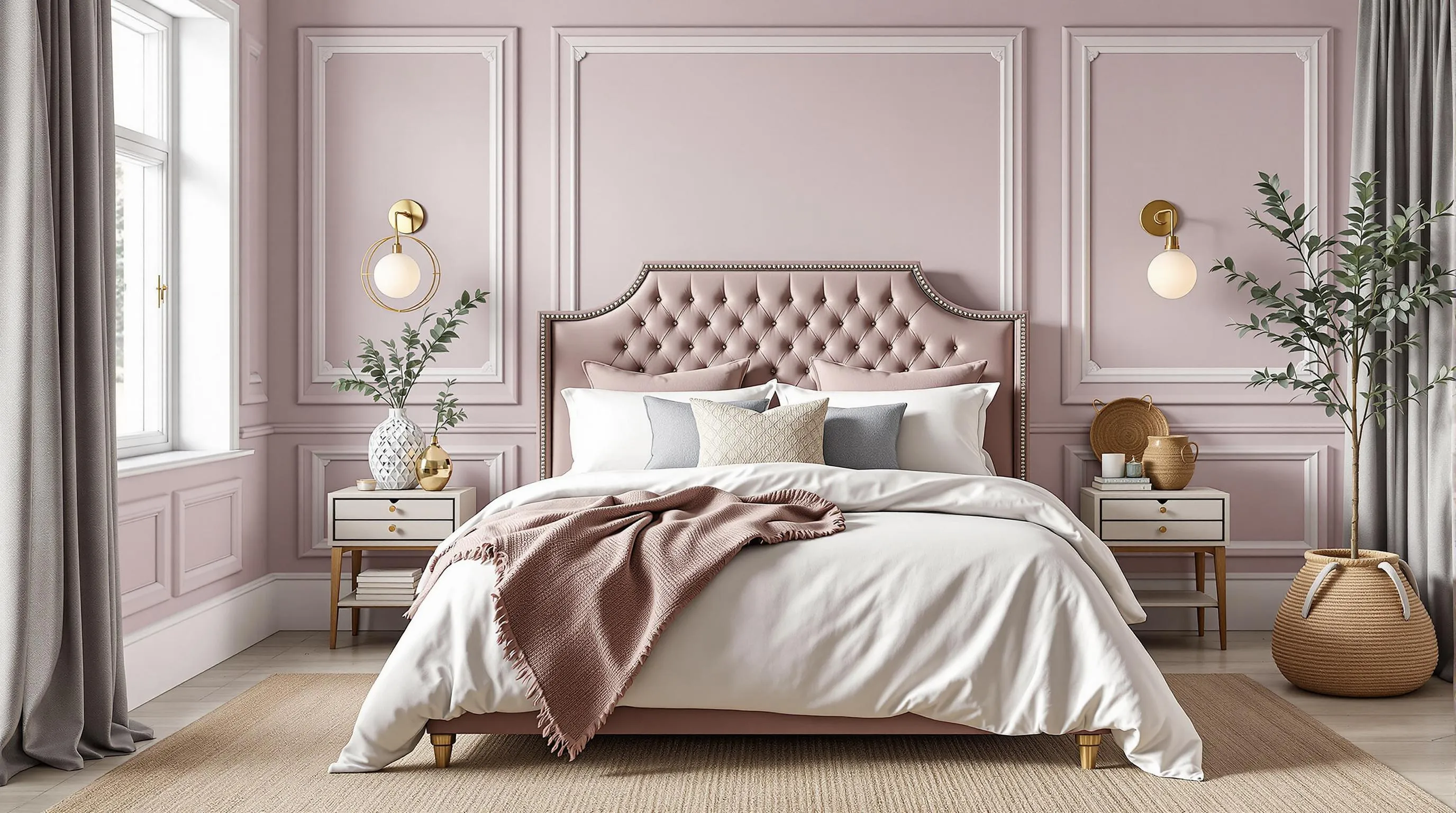
Dusty lavender stands out as a refined alternative to traditional purple tones, offering a muted, grayish undertone that blends tranquility with modern elegance. This versatile shade functions beautifully as a neutral in contemporary bedrooms, creating seamless harmony with warm wood tones and classic furniture pieces like sleigh beds. Its sophisticated nature allows it to pair effortlessly with white trim and various finishes, establishing a perfectly balanced aesthetic for discerning homeowners.
Mixing Dusty Lavender with Metallic Accents
Metallic elements create stunning contrast against dusty lavender’s soft backdrop, instantly elevating your bedroom’s sophistication factor. Gold accents particularly complement this shade, with table lamps, picture frames, or drawer pulls adding warm, luxurious touches throughout the space. Silver and brushed nickel fixtures offer a cooler alternative that enhances the lavender’s grayish undertones without overwhelming the room’s peaceful ambiance. Brass elements bring vintage-inspired warmth when paired with smoky lilac variations like Farrow & Ball’s Brassica, especially when balanced against crisp white woodwork for a timeless yet modern look. Mirrored nightstands reflect light beautifully in dusty lavender spaces, amplifying the room’s luminosity while maintaining its serene character.
Creating Depth with Dusty Lavender and Textured Finishes
Texture plays a crucial role in preventing dusty lavender rooms from feeling flat or one-dimensional. Plush velvet upholstery on headboards or accent chairs introduces luxurious depth while highlighting the color’s sophisticated nature. Linen bedding brings subtle texture through its natural weave, creating interesting visual variation against smoother painted surfaces. Color-drenching both walls and built-ins in coordinating dusty lavender shades (like Desert Mauve) transforms utilitarian storage into intentional design features. Natural elements such as woven baskets, jute rugs, or rattan accents provide organic contrast against the color’s refined character. Lighter variants like Farrow & Ball’s Sugared Almond maintain an airy quality while gaining substance through varying finishes and materials throughout the space.
For maximum versatility, we recommend pairing dusty lavender with complementary colors like gray, white, blush pink, or olive green to enhance its adaptability in various design schemes. Lighting significantly impacts this color’s appearance—soft natural light emphasizes its calming qualities, while warm bulbs enhance coziness in deeper lavender variations. This sophisticated shade works beautifully across design styles from minimalist to transitional to rustic approaches, proving its timeless appeal beyond passing trends.
Lavender Gray: The Subtle Neutral with a Purple Heart

Lavender gray strikes the perfect balance between neutrality and soft color, offering a sophisticated backdrop for bedrooms that feels both modern and timeless. This hybrid shade combines gray’s versatility with lavender’s soothing properties, creating spaces that calm the mind without sacrificing style.
How to Create a Calming Bedroom Retreat with Lavender Gray
Lavender gray walls provide an ideal foundation for a tranquil bedroom sanctuary. We recommend using this shade as your primary wall color, where its subtle purple undertones create depth without overwhelming the space. Enhance the calming effect by incorporating multiple textures throughout the room—velvet pillows, linen duvet covers, and knitted throws add dimensional interest while maintaining the serene atmosphere.
For furniture choices, gray upholstered headboards complement the wall color perfectly while lilac-painted nightstands introduce thoughtful color accents. Layer in soft lighting options that enhance lavender gray’s soothing qualities, including bedside lamps with warm-toned bulbs or string lights for a dreamy effect. Mirrors strategically placed opposite windows will amplify natural light, making the lavender undertones shimmer subtly throughout the day.
Complete your retreat by adding textural elements like plush area rugs, woven baskets, and crisp white curtains that maintain brightness while complementing the lavender gray palette. Fresh lavender plants or botanical prints featuring purple blooms can reinforce the theme while adding life to your peaceful sanctuary.
Pairing Lavender Gray with Wood Tones
Natural wood elements create striking harmony with lavender gray, offering warmth that balances the color’s cooler properties. Light woods such as oak or maple introduce an airy quality that keeps the space feeling open and bright. Walnut or cherry wood furniture creates beautiful contrast against lavender gray walls, adding richness and visual interest to the bedroom.
White or light gray furniture pieces work brilliantly alongside wood accents in a lavender gray bedroom. The combination creates a layered look that feels cohesive yet interesting. Consider incorporating wooden picture frames, floating shelves, or even a statement dresser to bring natural elements into your lavender sanctuary.
For maximum impact, mix wood finishes thoughtfully—perhaps a light oak floor with walnut bedside tables and a whitewashed wooden bench at the foot of the bed. This thoughtful layering of tones creates depth while maintaining the room’s restful qualities. Wooden accessories like decorative bowls or sculptural pieces add final touches that ground the ethereal lavender gray with natural warmth.
Deep Amethyst Lavender: Bold Drama for Statement Bedrooms
Deep amethyst lavender creates a bold, dramatic atmosphere perfect for statement bedrooms. This rich color blend combines the intensity of amethyst with soothing lavender tones to establish a luxurious feel without overwhelming brightness. We’ve noticed that rooms featuring this shade often evoke the sophisticated beauty of natural amethyst geodes with their shimmering lavender hues, adding an element of natural elegance to your space.
Balancing Deep Amethyst with Lighter Elements
Pairing deep amethyst lavender with neutral backgrounds prevents this bold shade from dominating your bedroom. White, cream, or gray walls create the perfect canvas for showcasing this dramatic color while maintaining a harmonious and luxurious ambiance. Natural light plays a crucial role in highlighting the subtle nuances of amethyst lavender, bringing out its depth and dimension throughout the day. Soft lighting fixtures can further accentuate the beauty of these rich purple tones during evening hours when natural illumination fades. Strategically placed lamps or sconces will enhance the color’s warmth and create an intimate atmosphere ideal for relaxation.
Creating Luxury with Amethyst Lavender Accents
Accent walls painted in bold amethyst or lavender instantly establish a striking focal point that anchors your bedroom design. This technique draws attention to architectural features while emphasizing the luxury and drama inherent to these deep purple shades. Velvet furnishings in lavender tones add both texture and depth to your space, improving the regal feeling that amethyst naturally provides. Plush throws, decorative pillows, and upholstered headboards in rich amethyst lavender create tactile interest that invites touch and reinforces the room’s luxurious atmosphere. Statement pieces like amethyst-colored glass lamps or decorative geode accessories can further highlight this color theme while adding sophisticated visual interest to your bedroom retreat.
Lavender Mist: The Ethereal Shade for Dreamy Sleepers

Lavender Mist stands out as a truly ethereal shade that creates a dreamlike atmosphere perfect for restful sleep. This lighter variation of lavender brings both calming properties and visual spaciousness to bedrooms of any size.
Using Lavender Mist in Small Bedrooms to Create Space
Lavender Mist works wonders in small bedrooms by creating an illusion of more space through its light reflective qualities. Small rooms immediately feel airier and more open when painted in this delicate shade, as it maximizes natural light reflection to visually expand tight quarters. The ethereal quality of Lavender Mist helps prevent the claustrophobic feeling that darker colors might create in compact spaces. Painting all walls in this gentle hue provides a cohesive, expansive feel throughout the room. For those hesitant to commit fully, even a single Lavender Mist accent wall can serve as a dreamy focal point while maintaining the spacious atmosphere small bedrooms need.
Layering Different Lavender Tones with Lavender Mist
Layering multiple lavender tones creates dimension and visual interest while maintaining the soothing atmosphere essential for bedrooms. Start with Lavender Mist as your base color on walls to establish an airy foundation for your color palette. Light and dark contrast works beautifully when combining Lavender Mist with deeper lavender hues through textiles like pillows, throws, and curtains. Incorporating neutral colors such as white, grey, or beige prevents lavender overload and keeps the space feeling balanced and sophisticated. Textural elements add depth to the layered color scheme—consider velvet pillows in deeper lavender against crisp Lavender Mist walls or a plush area rug in a complementary lavender shade. Accent walls offer another layering technique, where a deeper lavender tone on one wall contrasts with lighter Lavender Mist on remaining walls, creating depth without overwhelming the serene space.
Heather Lavender: The Earthy Tone That Grounds Your Space
Heather lavender offers a uniquely earthy approach to bedroom design, combining the calming properties of lavender with a natural, grounded feel. This versatile shade creates a serene sanctuary that balances tranquility with organic warmth, making it perfect for those seeking a peaceful retreat that maintains connection to nature.
Botanical Pairings for Heather Lavender Bedrooms
Botanical elements naturally enhance heather lavender’s earthy characteristics, creating a harmonious bedroom environment that feels both calming and rejuvenating. Delicate floral patterns complement this subtle lavender tone perfectly, adding visual interest without overwhelming the space. Plants and greenery serve as ideal companions to heather lavender walls, emphasizing the natural essence of this color while improving air quality and wellbeing.
Indoor plants with soft, rounded leaves work especially well against the earthy backdrop of heather lavender, creating a gentle contrast that draws the eye. Botanical wall art featuring pressed flowers or herbal illustrations can further reinforce the natural theme while adding personality to your space. Fresh lavender bouquets or potted lavender plants introduce authentic fragrance that enhances the room’s sensory experience, connecting the visual elements with aromatherapy benefits.
Textiles That Complement Heather Lavender Walls
Natural fabrics provide the perfect textural complement to heather lavender walls, improving the organic feel while adding comfort and dimension. Linen bedding in neutral tones creates a relaxed, lived-in aesthetic that pairs beautifully with this earthy lavender shade. Cotton throws in complementary hues like sage green or warm beige add layers of interest while maintaining the room’s grounded atmosphere.
Plush rugs underfoot introduce comfort and warmth, with natural fiber options like wool or jute reinforcing the bedroom’s connection to nature. Velvet accents in deeper purple tones can create subtle dimension against the heather lavender background. Upholstered furniture pieces in complementary colors serve as anchoring elements that tie the room together while providing functional comfort.
Window treatments in lightweight natural fabrics allow ample light to filter through, highlighting heather lavender’s ability to shift subtly throughout the day as lighting changes. Textured pillowcases and cushions in varying neutral shades add depth while maintaining the calming properties that make heather lavender such an excellent choice for restful bedroom spaces.
Icy Lavender: The Cool-Toned Option for Contemporary Spaces
Icy lavender offers a refreshing, modern touch that perfectly suits contemporary bedroom designs. This cool-toned shade creates a clean, minimalist aesthetic while maintaining lavender’s inherently calming properties. When paired with crisp whites, light grays, and natural woods, icy lavender establishes a Scandinavian-inspired setting that feels both airy and spacious.
Creating Scandinavian-Inspired Bedrooms with Icy Lavender
Incorporating icy lavender walls serves as an excellent foundation for a Scandinavian-inspired bedroom retreat. Natural textiles like linen or cotton bedding complement this cool shade while adding essential texture to the space. Sleek wooden furniture pieces with clean lines maintain the minimalist aesthetic that defines Scandinavian design. Patterns should be kept minimal and understated to preserve the uncluttered feel characteristic of this style. Soft, ambient lighting enhances the calming atmosphere, making your bedroom ideal for unwinding and relaxation after a long day. Consider pendant lights with simple designs or streamlined floor lamps that provide gentle illumination without visual complexity.
Balancing Icy Lavender with Warmer Elements
Icy lavender’s cool nature benefits from thoughtful balancing with warmer elements to avoid a chilly atmosphere. Rustic accents such as wooden headboards, nightstands, or natural fiber rugs instantly add warmth and organic character to the space. Soft textures play a crucial role in creating coziness—plush throw blankets draped across the foot of the bed or velvet pillows in neutral tones invite touch and comfort. Golden accents like brass light fixtures, picture frames, or decorative objects introduce an elegant warmth that beautifully contrasts with the cool lavender backdrop. These warming elements harmonize the cool tone of icy lavender, resulting in a bedroom environment that feels simultaneously modern and cozy, striking the perfect balance between contemporary design and comfortable living.
Lavender Blush: Where Pink and Purple Create Perfect Harmony
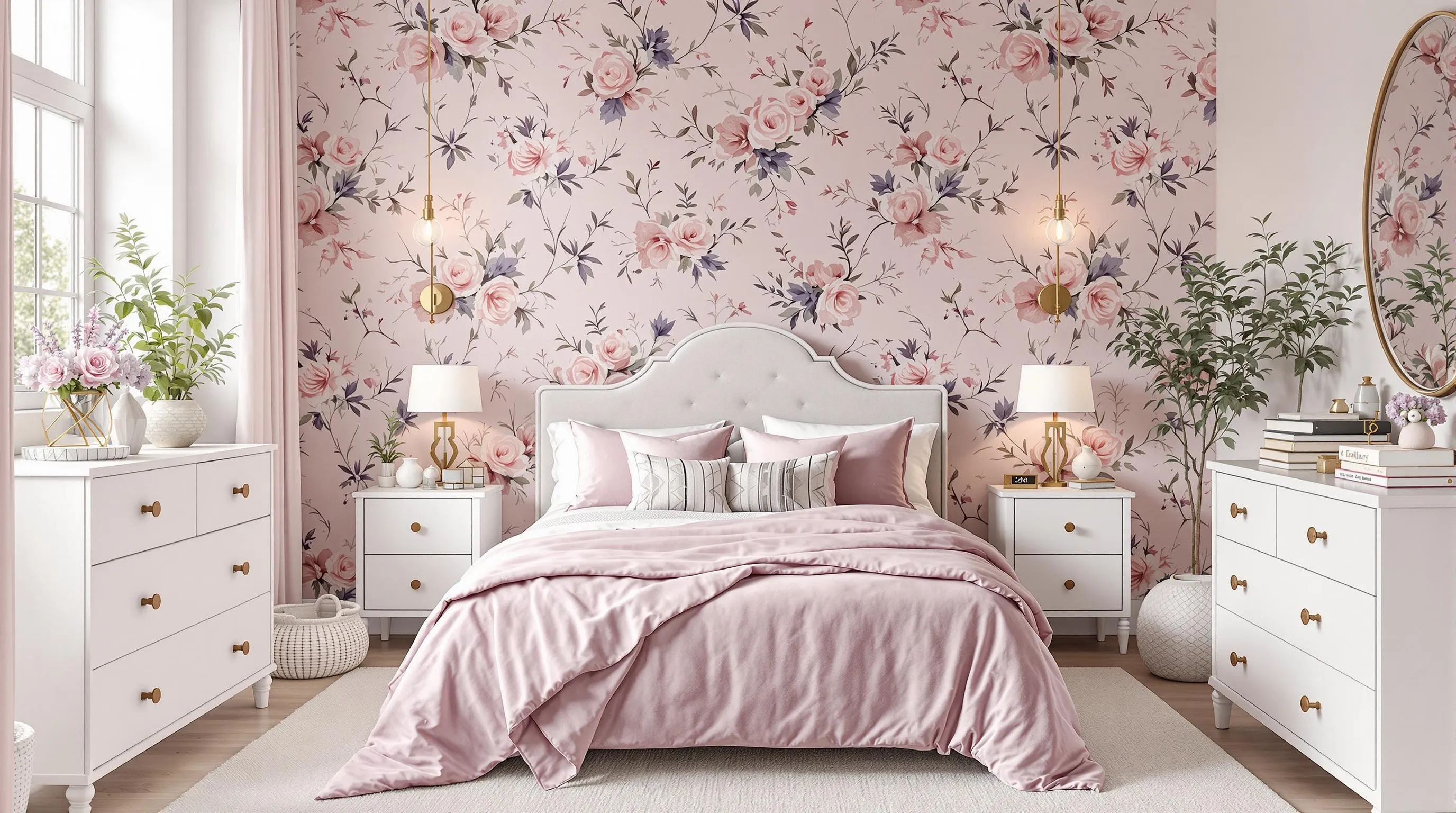
Lavender Blush offers a delicate blend of pink and purple tones that creates a versatile backdrop for bedroom design. This subtle hue harmonizes beautifully with neutrals like white, cream, or gray, providing perfect balance while adapting to both pastel-centric and bold contemporary schemes.
Creating Romantic Bedroom Settings with Lavender Blush
Romantic bedroom aesthetics thrive with Lavender Blush’s inherent softness through thoughtfully layered textures. Metallic accents such as gold or brass fixtures instantly elevate the elegance of this gentle shade. Plush fabrics like velvet complement the softness of Lavender Blush, creating tactile interest that enhances the romantic atmosphere. Combinations with blush pink bedding or mauve walls evoke warmth and intimacy in the space. Floral patterns incorporated through wallpaper, bedding, or artwork amplify the romantic feel while maintaining sophistication. Ambient lighting plays a crucial role in improving the cozy atmosphere, with soft, warm illumination bringing out the nuanced undertones of this delicate color.
Child-Friendly Bedroom Designs Using Lavender Blush
Children’s rooms benefit significantly from Lavender Blush’s gentle tone, fostering both calmness and creativity. White furniture creates a clean, balanced look against Lavender Blush walls, allowing the color to shine without overwhelming young sensibilities. Designers frequently pair this shade with lavender and pink accents to create playful yet soothing environments, as demonstrated in Ariyona Interior’s “bright and spunky” approach. Removable wall decals offer flexibility as children grow and their preferences evolve, without requiring a complete room redesign. Gender-neutral accessories work perfectly with this versatile hue, making it appropriate for any child’s space regardless of age or preferences. Natural materials introduce texture while maintaining the tranquil qualities that make Lavender Blush ideal for restful sleep in children’s bedrooms.
How to Choose the Perfect Shade of Lavender for Your Bedroom
Transforming your bedroom with lavender isn’t just about following trends—it’s about creating your personal sanctuary. Whether you prefer the subtle elegance of Soft Lilac or the dramatic luxury of Deep Amethyst we’ve explored options for every aesthetic preference.
Remember that lighting plays a crucial role in how your chosen shade appears throughout the day. Test samples on different walls and observe them at various times before committing.
The beauty of lavender lies in its versatility—it works with virtually any design style from rustic French countryside to sleek Scandinavian minimalism. Start with pillows or accessories if you’re hesitant about painting entire walls.
Your bedroom should reflect your personality while promoting restful sleep. With these dreamy lavender options you’re well-equipped to create the tranquil retreat you deserve.
Frequently Asked Questions
Why is lavender a good color choice for bedrooms?
Lavender promotes relaxation and better sleep due to its calming properties. This versatile color creates a tranquil atmosphere while offering options ranging from soft lilac to deep amethyst. Research suggests purple tones can reduce stress and anxiety, making lavender ideal for creating a peaceful bedroom retreat where you can unwind at the end of the day.
How can I incorporate lavender into my bedroom without painting the walls?
Add lavender through textiles like throw pillows, duvet covers, or curtains. Consider lavender-toned rugs, artwork with lavender elements, or decorative items like vases or lampshades. Dried lavender bundles provide both color and aromatherapy benefits. These non-permanent options let you enjoy lavender’s calming effects without committing to wall paint.
What colors pair well with lavender in bedroom design?
Neutrals like white, cream, gray, and beige complement lavender beautifully. For more depth, try blush pink, olive green, or sage. Metallics (particularly gold and silver) add sophistication, while natural wood tones create warmth. The versatility of lavender allows for both contrasting and harmonious color pairings depending on your desired atmosphere.
Is lavender suitable for small bedrooms?
Yes, lighter lavender shades like Lavender Mist are ideal for small spaces as they reflect light and create an illusion of more space. Stick to softer tones (Whisper Lilac or Lavender Gray) rather than deeper purples to prevent the room from feeling cramped. Use mirrors and proper lighting to enhance the spacious feel that light lavender provides.
How do I choose the right shade of lavender for my bedroom?
Consider your bedroom’s natural light first—rooms with abundant sunlight can handle deeper shades, while dimmer spaces benefit from lighter tones. Think about your desired atmosphere: Dusty Lavender for sophistication, French Lavender for rustic charm, or Deep Amethyst for drama. Test samples on your wall to see how they look in different lighting throughout the day.
What lighting works best with lavender bedrooms?
Warm white LED bulbs enhance lavender’s soothing properties without distorting the color. Layer lighting with ceiling fixtures, wall sconces, and bedside lamps for flexibility. Dimmable options are ideal for adjusting the mood. Natural light showcases lavender beautifully, so maximize windows during the day while using soft, ambient lighting in the evening.
Can lavender work in a masculine bedroom design?
Absolutely! Choose sophisticated lavender shades with gray undertones like Lavender Gray or Dusty Lavender. Pair with darker accents in charcoal, navy, or black, along with leather elements and minimalist furniture. Industrial touches like metal fixtures or exposed brick complement these lavender tones while maintaining a balanced masculine aesthetic.
Does lavender actually help improve sleep quality?
Yes, research suggests lavender can improve sleep quality. The color psychology behind lavender promotes relaxation and stress reduction, while actual lavender scent has been shown to lower heart rate and blood pressure. The combination of visual calming effects and optional aromatherapy creates an ideal environment for restful sleep and reduced insomnia symptoms.
How can I use textural elements with lavender walls?
Balance lavender’s softness with varied textures—plush velvet pillows, knitted throws, or linen bedding add dimension. Consider woven headboards, textured wallpaper, or macramé wall hangings. Wood elements provide natural contrast, while metallic accents create sophisticated highlights. These textural elements prevent lavender from feeling flat while enhancing its soothing qualities.
Is it better to use lavender as an accent or as the main color?
This depends on your comfort level with color. As a main wall color, lighter lavender shades create a serene envelope. If you prefer subtlety, use neutral walls with lavender accents through bedding, artwork, and accessories. An accent wall in deeper lavender offers a balanced approach. Either way, lavender’s versatility ensures it works well in any proportion.






